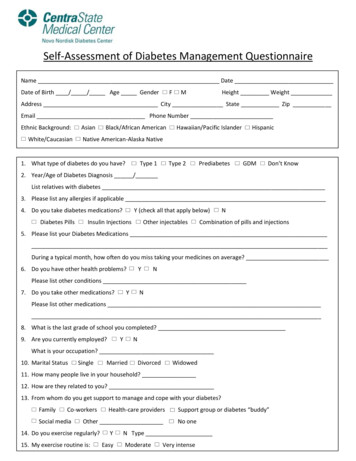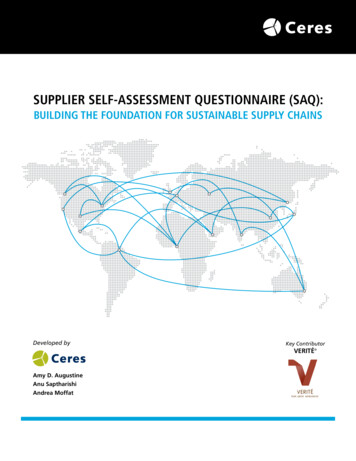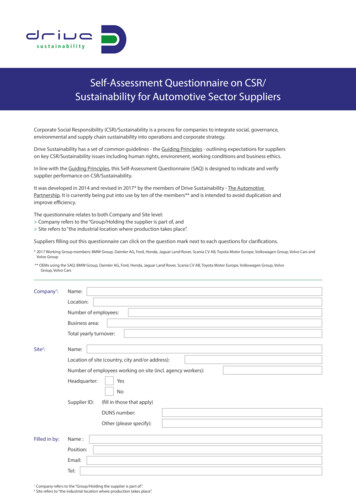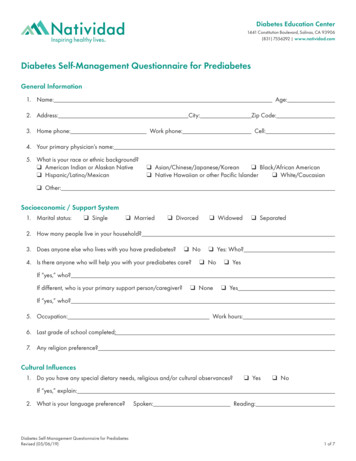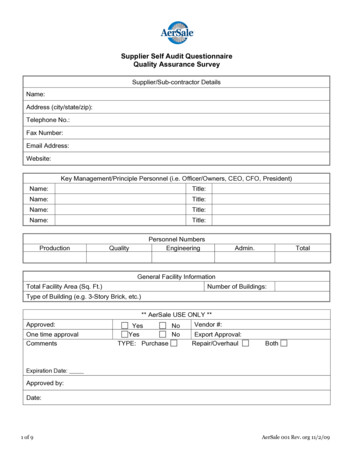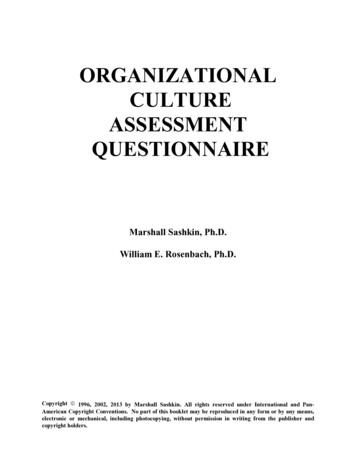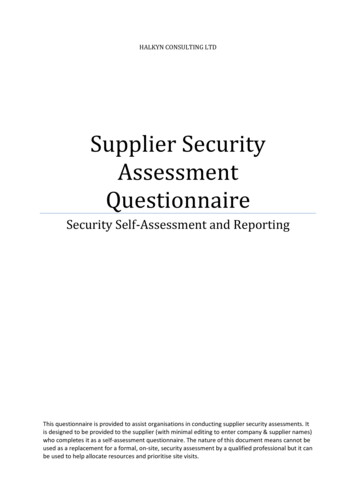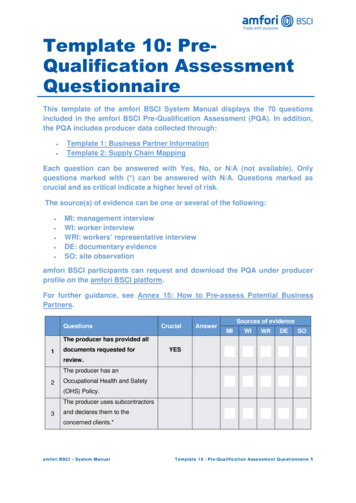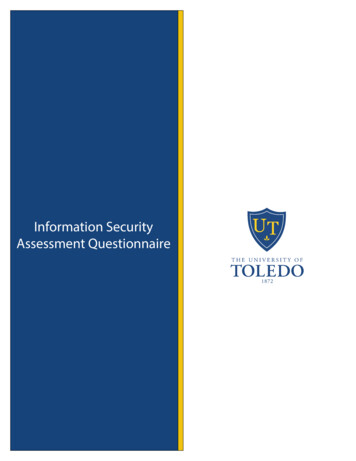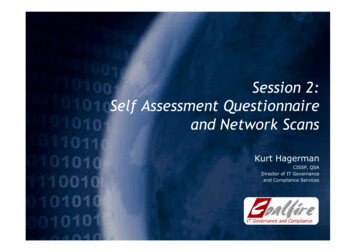
Transcription
Session 2:Self Assessment Questionnaireand Network ScansKurt HagermanCISSP, QSADirector of IT Governanceand Compliance Services
Agenda Session 1: An Overview of the Payment Card Industry Session 3: Application Security Q&A
Your Requirements (Level 2,3,4)If you STORE, PROCESS, or TRANSMIT cardholder data then:1. You must meet the requirements of the PCI DSS2. You must fill out a Self Assessment Questionnaire annually3. You must have quarterly external network scans conducted by aqualified ASV.
What is the Data Security Standard (DSS)What is the Data Security Standard (DSS)? 200 Specific requirements rather than vague guidelines DSS applies to all merchants all major brands. Permits for “compensating controls” (a term often misunderstood) Includes technical configuration requirements, business justification, policies,risk assessments, etc. NOT JUST AN I.T. ISSUE! – Finance, HR, Operations, Legal, etc.
6 Control Objectives, 12 Requirements5
Sample Requirements1.1Establish firewall and router configuration standards that include thefollowing:1.1.1 A formal process for approving and testing all network connectionsand changes to the firewall and router configurations1.1.2 Current network diagram with all connections to cardholder data,including any wireless networks1.1.3 Requirements for a firewall at each Internet connection and betweenany demilitarized zone (DMZ) and the internal network zone1.1.4 Description of groups, roles, and responsibilities for logicalmanagement of network components1.1.5 Documentation and business justification for use of all services,protocols, and ports allowed, including documentation of securityfeatures implemented for those protocols considered to be insecure1.1.6 Requirement to review firewall and router rule sets at least every sixmonths
PCI DSS Security Audit Procedures
Navigating the DSS
Quick Review The Data Security Standard (DSS) applies to everyone whostores, processes, or transmits cardholder data. The DSS has:6 Control Areas12 General Requirements200 Specific Requirements The PCI Assessment Procedures is used by QSA’s for formalassessments, and provide testing criteria. Navigating the DSS is a document to help merchants withunderstanding the requirements.
What is the Self Assessment Questionnaire (SAQ)?
Your Requirements (Level 2,3,4)What you must do, and how you must validate are totally separate.All merchants must be PCI compliantLevel 2, 3, and 4 merchants validatecompliance through the SAQand quarterly scans.
SAQ and ASA SAQ: Self Assessment Questionnaire / ASA: Annual Self AssessmentAvailable at www.pcisecuritystandards.org
SAQ
SAQ “D”
Sample Questions
Compliance/Non-Compliance
The following slides are VERY important
This is VERY important:
Don’t EVER keep TRACK DATAPCI prohibits merchants ortheir agents from storing themagnetic-stripe data after theresponse to the authorizationrequest has been received.Due to the serious nature ofcompromising cardholder data,Card Associations haveimplemented substantialpenalties for non-compliance.
Track 1 Data20
Track 2 Data
CVV2
How do I know? Inventory all your data (including paper files). Search for *.log or *.txt Focus on large files, or files which are generated periodically. Search key terms “Card” “CC” “Credit Card” “Batch” \windows\system32\logfiles directory with a focus on the W3SVC1 Within all sampled files search for “ ” and “ ” to help identify trackdata. SQL queries “credit card data” “transaction table” Search tools are available.
Coalfire’s Navis and RapidSAQ Navis provides Coalfire customers with a robust suite of online tools tomanage their IT governance and regulatory compliance programs. The platform allows you to not only manage compliance and audit plans,regulated assets, and controls, but also manage your Coalfire servicesand deliverables. Structured, interactive engine walks users through process andgenerates all appropriate documents Based on your responses Rapid SAQ: Automatically determines the appropriate validation type (A, B, C or D)for the merchant Presents only those required questions Removes questions that are not appropriate Robust reporting with easy to read graphic stats Track your compliance against industry trends Can manage multiple entities from one management page (e.g.franchises and/or multiple locations)
Coalfire’s Navis Platform
What are Quarterly Network Scans?
PCI Scanning Procedures v1.2 Quarterly vulnerability scans (both internal and external) are required byPCI DSS 11.2 External vulnerability scans are conducted over the Internet andrequired to be performed by an ASV. Internal vulnerability scans must be conducted against all CDE systemsand can be done by internal IT staff. These scans are an indispensable tool to be used in conjunction with avulnerability management program. Scans help identify vulnerabilitiesand miss-configurations of web sites, applications, and informationtechnology (IT) infrastructures. Scan results provide valuable information that support efficient patchmanagement and other security measures that improve protectionagainst Internet and internal attacks.
PCI Scanning Procedures v1.2The PCI DSS requires all Internet-facing IP addresses as wellas internal CDE systems to be scanned for vulnerabilities.In some instances, companies may have a large number of IPaddresses available while only using a small number for cardacceptance or processing. In these cases, ASV’s can helpmerchants and service providers define the appropriate scopefor the external scan required to comply with the PCI DSS.
What type of systems should be scanned?1. Client provides the list of public IP addresses to scan toan ASV.2. A network probe discovers live devices.3. The IDS/IPS must not interfere with the scan4. You must scan all:1. Web Servers2. Application and Database Servers3. Domain Name Servers4. Mail Servers5. All Virtual Hosts6. Wireless Access Points7. Routers and Firewalls8. Operating Systems
Sample Report
Sample Report
Vulnerability Severity Levels
How are scans ranked?
Technical and OperationalRequirements for ASV’s
But there are still risks with scans Routers/Firewalls- Some can’t handle the traffic and have to be reset resulting in thenetwork going down. Operating Systems- Some systems are built off older systems (like NT) and mayreact strangely to scans (i.e. VOIP systems). Custom Web Application Checks (XSS, SQL)- Scanning solutions are becoming more sophisticated at checkingapplication vulnerabilities. Web spidering, and SQL injection testsmay lead to denial-of-service type experiences.
Key Points Under what circumstance you can store sensitiveauthentication data post authorization? What is “sensitive authentication data”? How can you search for sensitive authentication data? What is the difference between the DSS, SAQ, andscans?
End of Session 2Next up. Application Security
2. A network probe discovers live devices. 3. The IDS/IPS must not interfere with the scan 4. You must scan all: 1. Web Servers 2. Application and Database Servers 3. Domain Name Servers 4. Mail Servers 5. All Virtual Hosts 6. WirelessAccess Points 7. Routers and Firewalls 8. Operating Systems
